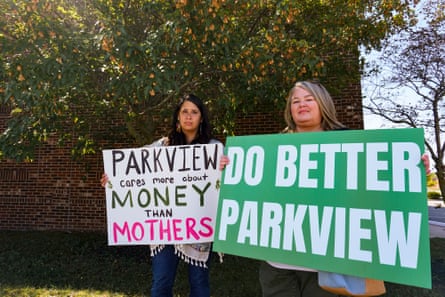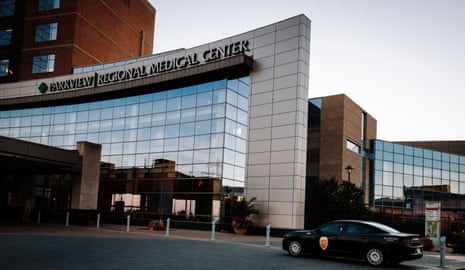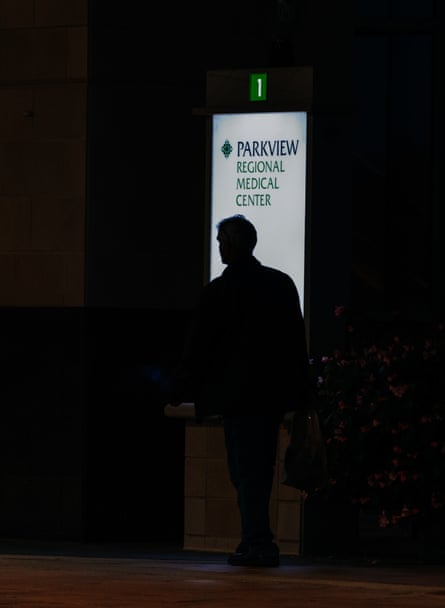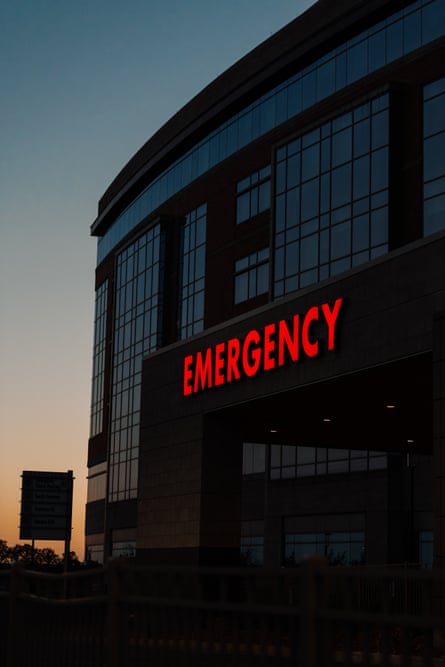On an October evening, Tom Frost was zooming down a dark state road on the northern edge of Indiana. The father of two had just finished his shift at a small town fiberglass factory. Now, he was doing what he loved, riding a Harley Davidson in his typical getup: black gloves, leather chaps, no helmet.
As Frost revved past the corn fields and thinning birch trees that led to his girlfriend’s house, a green pickup jerked off a side road and into his path.
Frost didn’t have time. He hit the truck and flew backwards, leaving his body and small trails of blood on the asphalt, police photos show.
First responders loaded Frost, now incapacitated, onto a helicopter and flew him to the area’s biggest hospital, Parkview Health’s Regional Medical Center. The sprawling, near-million square foot campus had opened its doors a year earlier, the capital of a rapidly expanding empire of hospitals and doctors offices spreading out from Fort Wayne to the rural counties of the Indiana-Ohio borderlands.
Parkview Health’s doctors operated on Frost’s fractured right leg and face. Eventually, he woke up from his coma. But for weeks afterwards, he suffered from significant brain trauma. He called his mother, who spent days sitting beside his hospital bed, “Number 1”, not “Mom”.
So about a month after the 2013 crash, when a hospital employee pulled aside his mother and asked her to sign an agreement promising to pay for “all” of her son’s charges, the 66-year-old retired bartender signed where she was told.
Frost’s mother didn’t know how much the bill was going to be. All she knew was that her son, who was uninsured, needed care.
After Frost’s discharge, Parkview Health, a not-for-profit system, sent him a letter outlining how much it wanted: $629,386.50.
Frost’s family was willing to pay, according to a subsequent court filing submitted by his attorney. But the bill was bigger than what they thought was reasonable. For example, after his high-level surgeries, Parkview transferred him to a skilled nursing facility, where he worked on his rehab and recovery for 55 days. For that period, the hospital wanted $144,487.73, effectively a daily charge of more than $2,600.
An auditor hired by the family’s attorney identified thousands of dollars in billing errors in the hospital’s itemized statement, some of which the hospital later relented on. More significantly, going off of federal billing guidelines, the auditor concluded the “fair and reasonable value” of the services Frost received actually amounted to $255,903.45 – still a hefty sum, but only about 40% of what the hospital was demanding.
After a two year legal battle that threatened to shed light on Parkview’s closely-guarded billing practices, the hospital had Frost sign a confidentiality agreement and settled the case for an undisclosed sum.
But the enormous hospital bill Parkview sent to Frost was not an aberration.
Over more than a decade, Parkview Health has demanded that the people of north-eastern Indiana and north-western Ohio pay some of the highest prices of any hospital system in the country – despite being headquartered in Fort Wayne, Indiana, which currently ranks as the No 1 most affordable metro area to live in the United States. For 10 of the last 13 years, Parkview hospitals on average have been among the top 10% most expensive in the country, a Guardian US analysis of cost estimates based on data submitted to the Centers for Medicare and Medicaid shows.

Parkview’s steep prices are the product of a more than two decade campaign by hospital executives to establish market dominance in Fort Wayne and to squeeze revenue from a pool of patients and employers who feel they have no better alternatives, according to interviews with more than 40 current and former Parkview employees, patients, local business leaders, lawmakers and competitors, as well as leaked audio recordings of meetings and hundreds of internal billing, patient and policy documents obtained by the Guardian.
During this period, Parkview has taken over six former rival hospitals and built up a network of almost 300 sites for its physicians and providers, forming a ring around its gleaming regional center, which some staff refer to in private as the “Big House” or “Emerald City” for its ritzy amenities and green corporate branding.
This consolidation, former employees say, has allowed Parkview to control referral flows, routing primary care patients to their own costly specialists and facilities, even if those patients could get the same services elsewhere for less. It has also increased Parkview’s leverage in negotiations with health insurance companies, as they bargain over procedure prices on behalf of employers that offer the insurers’ health plans to their workers.
Insurance industry sources say Parkview’s growing web of hospitals makes it hard for any insurer to offer a viable health plan locally without including the chain’s facilities in their network, an advantage that has helped the not-for-profit extract high prices and earn a reputation as one of the toughest negotiators in the state.
Not-for-profit healthcare has been good business for Parkview as it has been for hundreds of other ostensible charities across the US which operate nearly half of the nation’s hospitals. In exchange for generous tax breaks, these institutions are required to provide free and discounted care to poor patients, but many have faced criticism for skimping on charity care, demanding high prices and giving executives exorbitant salaries.
Since 2019, Parkview has raked in more than $2bn in revenue annually, enabling the system to give dozens of its executives and top doctors six and seven figure annual compensation packages. Before his retirement at the end of 2022, Parkview’s longtime CEO, an avowed Christian who publicly styled himself as a “servant” leader, took home nearly $3m from the not-for-profit, according to the system’s last publicly available IRS disclosure.
Parkview declined repeated requests in recent weeks to make its current CEO available for interview and chose not to respond to a series of detailed questions submitted by the Guardian several days ahead of publication. In response to criticism about its high prices, Parkview has previously pointed to its various charitable initiatives, its role as a leader in the region’s economic development, and the quality of its care – which varies by facility according to federal ratings. The system has also claimed that past studies of its prices have been “filled with inaccuracies” and “incomplete analyses”.
Parkview’s expansion in Fort Wayne, a mid-sized, midwestern city surrounded by miles of corn fields and manufacturing plants, reflects a larger trend of consolidation that has transformed America’s once mostly locally run healthcare system and ratcheted up its costs for more than a generation.
Since the 1990s, hospital systems across the US – for and not-for-profit alike – have relentlessly chased after market power, executing nearly 2,000 mergers with little pushback from overwhelmed federal antitrust regulators and indifferent state authorities. Research from the American Medical Association found that by 2013, 97% of healthcare markets in the US had little competition and were highly consolidated under Department of Justice antitrust guidelines. By 2021, that figure had risen to 99%.
With consolidation, academic researchers have consistently found significant increases in prices. A 2012 research survey concluded that when hospitals merge in concentrated markets price hikes were “typically quite large, most exceeding 20 percent”. A 2019 study found that prices at hospitals enjoying local monopoly power were 12% higher than those in markets with at least four competitors. A study released earlier this year identified dozens of hospital mergers that it said regulators could have flagged as likely to diminish competition and raise prices. Those mergers did, in fact, result in average price hikes of 5% or more, the researchers found.

Rising healthcare costs don’t just hurt patients. They also squeeze local employers, who have to choose between wages, headcount and insurance costs – decisions that low-wage workers pay for down the line. A working paper from earlier this summer found that every 1% increase in healthcare prices, driven by hospital mergers, lowered both employment and payroll at companies outside the health sector by approximately 0.4% – trends, which in turn, increased deaths by opioid overdose and suicide.
Zack Cooper, a Yale economist and one of the co-authors of that paper, argues that consolidation has its most pernicious effects in areas like north-eastern Indiana and north-western Ohio, where Parkview has established itself as the dominant player: semi-rural parts of the country which already had comparatively few healthcare providers and are even more vulnerable to consolidation and price hikes.
“That’s where you start to see these 10 to 15% price increases over time,” said Cooper. “Outside of New York, LA, Chicago and Houston, often the hospitals are really the biggest employers in town. They’ve got these beautiful campuses and rolling grass lawns, and you say, ‘Oh gosh, this is good for the economy.’ But what we’re starting to see is that many of our local health systems are boa constrictors just tightening around and squeezing the life of some of these local economies.”
The not-for-profit cut services. Then a young mother died
Parkview Health is now north-eastern Indiana’s largest employer. And as the hospital system has grown, it has refashioned greater Fort Wayne in its own image.
Parkview has built its own police force with dozens of armed officers stationed across the region. It has stuck its green and gray colors on the jerseys of Fort Wayne’s minor league baseball team, and paid millions to call their downtown stadium, “Parkview Field”. Today, even the local hockey rink, “SportOne Parkview Icehouse”, and a local YMCA, “Parkview Family YMCA”, pay homage to the not-for-profit.

In Fort Wayne and its surrounding deep-red counties, business leaders and Republican state lawmakers have grumbled for years about Parkview’s high prices – including several who spoke on the condition of anonymity for this story. But no major establishment figure has been willing to cross the hospital.
Last summer, the biggest ever local challenge to the not-for-profit’s carefully cultivated reputation came not from elected officials, but a spontaneous coalition of suburban and rural mothers from DeKalb county. The women, calling themselves “Moms Against Parkview”, were upset that the healthcare system had decided to shut down the labor and delivery unit at their local formerly independent hospital, which the system had absorbed and rechristened as “Parkview DeKalb” in 2019.
In a statement to the media, the prosperous not-for-profit likened itself to the hundreds of struggling rural hospitals nationwide that have cut maternal care services: “Across the country, rural hospitals have experienced ongoing challenges in ensuring sustainable access to high-quality obstetrics services.”
The protesters didn’t buy this explanation, which they assumed was a convenient excuse for Parkview to slash a money-losing service line. Standing at an intersection near the gargantuan Regional Medical Center last September, several women and their children held handmade signs, declaring in scrawled marker: “Save DeKalbs OB Unit” and “Parkview puts $$$ over mothers!”

That month, Michelle Dunn, one of the protesters, submitted an anonymous letter to a local newspaper, which she told the Guardian she had received from a nurse working at Parkview Dekalb. “Shutting our unit down would be detrimental to women and their children especially when they cannot make it to Parkview Regional,” the letter stated.
Parkview executives largely ignored the women. A few weeks later, the anonymous writer’s warning proved prescient.
Late in the day on 10 October 2023, a 26-year-old named Taysha Wilkinson-Sobieski showed up at Parkview DeKalb looking pale, according to one current and one former hospital source.
Parkview hadn’t approved 24/7 onsite ultrasound coverage – a basic medical imaging tool – at the outlying hospital, according to two former Parkview employees with knowledge of the incident. But because of her vitals, the two former employees said, staff suspected she was bleeding internally due to an ectopic pregnancy, a potentially life-threatening condition in which an egg grows outside of the uterus.
Even after the closure of the labor and delivery unit, Parkview Dekalb still had OB-GYNs who did pre-scheduled procedures and an on-call general surgeon who had the technical skills to try and help Wilkinson-Sobieski, two current and two former Parkview employees told the Guardian.
But alongside the publicly-announced unit closure, hospital executives had also quietly slashed on-call OB-GYN emergency coverage at Parkview DeKalb, so the de facto practice became for staff to transfer pregnancy-related emergencies to Parkview Regional Medical Center, a 20-minute drive away, one current employee and one former high-ranking Parkview employee with knowledge of the matter said.

The transfer cost Wilkinson-Sobieski time she could not afford.
When the young woman arrived at the regional hub, she was still conscious and doctors were waiting for her, according to a source familiar with her post-transfer care. Staff ran an ultrasound, put her to sleep with anesthesia, and began an operation to put a clamp across one of her fallopian tubes, which by this point had ruptured, the source said.
They got to her too late. She had already lost too much blood. She never woke up again, the source said.
Wilkinson-Sobieski was pronounced dead two days later. She left behind her husband Clayton and their one-year-old son, Reid.
Afterwards, her family received a bill from Parkview, according to her husband and another person familiar with the matter.
Parkview did not respond to numerous detailed questions from the Guardian about the sources’ claims regarding the case, and declined to comment for a previous story about the case in the Indianapolis Star.
In a previous statement to local press about its OB-GYN service cuts, Parkview said its “unwavering commitment to healthy moms and babies” was at “the heart” of its new approach, which it claimed would create “new opportunities to optimize prenatal care, labor and delivery, and postnatal care”.
But current and former Parkview employees told the Guardian the case points to the dangers of treating medicine like a business.
“What do you do about the ectopic? What do you do about the mom that comes in with a foot hanging out?” said one current longtime medical provider at Parkview, who spoke on the condition of anonymity. “At the end of the day, that’s why the practitioners routinely say, ‘This cannot be quantified.’ Medicine does not fit neatly into an excel spreadsheet.”
The duo that built ‘Emerald City’
With a price tag of over $600m, Parkview’s Regional Medical Center – a campus of brick walls and glass panes – is one of the most expensive developments in north-eastern Indiana.
When patients walk through the sliding doors of its main entrance, they enter a bright atrium. Light floods through the front windows, revealing its immaculate floors and a grayscale glass mural that includes engravings of surgery staff and a motto in cursive: “Generosity Heals.”
This is the house that Parkview built – and that the patients and employers of greater Fort Wayne paid for with some of the highest prices across the land.

The ever-expanding campus was a crowning achievement for Parkview’s longtime CEO, Michael Packnett, who retired two years ago, having turned the system from a small community chain into a regional powerhouse.
During his 16-year tenure, Packnett, a doughy-faced Oklahoman with a soft voice and a graying widow’s peak, won near universal acclaim for his carefully-cultivated brand of “servant leadership”.
Former employees, from nurses to executive team leaders, reminisce about how Packnett would walk the halls and shake the hands of subordinates, whom he called “co-workers” in public pronouncements.
Even today, local critics of the hospital find it hard to believe Packnett could have been in the know about the hospital’s more controversial charging and acquisition tactics. What they don’t like, they sometimes ascribe to Rick Henvey, Packnett’s longtime deputy and eventual successor. Henvey, a balding Texas native with a taut face, does not project Packnett’s “care bear” image, as one Republican lawmaker put it.
But sources who dealt with both over their 23-year partnership say that, in their business practices, the two were closely aligned.
Henvey followed Packnett to Fort Wayne. What they built there, one of the wealthiest hospital systems in Indiana, they built together – a trajectory that was not inevitable.
When the duo took over Parkview in 2006, Fort Wayne – then a city of around 250,000 – had a relatively competitive hospital market. Parkview had a slightly smaller regional market share than a for-profit competitor, and struggled with wobbly revenues, tough dealings with insurers, and a lack of bed capacity – causing it to sometimes lose patient referrals to its rival.
With the arrival of Packnett and Henvey, the hospitals’ operating revenues exploded, rising from around $700m at the close of 2006 to $1bn by the end of 2011 – a 40%-plus increase, though patient admissions only grew 11% during that period, according to Moody’s Ratings reports from the time.
Hospital industry rivals and insurance sources attribute a large part of Packnett’s success in those early days to his team’s aggressive acquisition of dozens of freestanding medical facilities, including doctors’ offices, imaging sites and surgery centers.
Like many hospital leaders across the country, Parkview administrators sometimes reclassified these acquisitions as “hospital-based” outpatient departments, according to one former Parkview employee and two healthcare industry sources familiar with the matter.
The reclassifications didn’t fundamentally change the services offered and the facilities were not necessarily on Parkview hospital campuses, sources asserted, but thanks to lax Medicare and commercial insurance reimbursement practices, administrators could insert the hospital’s tax identification number, a hospital address, and higher charges onto bills from these sites.
“So Packnett shows up here from Oklahoma and he realizes he has unlimited dollars,” recalled one rival hospital executive, who was operating in Fort Wayne at the time.
Around 2010, Packnett and Henvey saw an opportunity for this kind of billing arbitrage across state lines in Bryan, Ohio. The town of less than 10,000 people had a small community hospital that was fighting to keep its independence as well as an aging doctors group that was looking to cash out.
Packnett and Henvey wanted both, according to the Bryan hospital’s then CEO Phil Ennen. But when the duo couldn’t convince the local hospital to surrender, they settled for the doctors’ practice, which had its own facility doing affordable imaging and lab work right across the street.
Then the Fort Wayne not-for-profit executives jacked up prices, Ennen recalls.
Suddenly, he said, patients in Bryan receiving imaging from the same personnel in the same facility, were on the hook for hundreds of dollars more in charges because of its hospital-based reclassification, a spike that sparked complaints from local employers.
“It’s a powerful aphrodisiac, right?” said Ennen. “We can take ’em over and take their lab and their X-ray and make it ours, and charge our prices.”
Packnett’s physician grabs also softened up hospital targets for poaching down the line, according to one former high-level Parkview employee. With the Bryan doctors’ group now in Parkview’s hands, Ennen noted, the system began siphoning referrals away from the Ohio community hospital – shifting hospital facility fees and future patient visits from Bryan west to Fort Wayne.
Thirteen years later, struggling with finances, the community hospital group that operated the hospital in Bryan and another one in a nearby small town finally gave in and joined Parkview.
“They put Parkview doctors in Ohio and took their volume away,” recalled the former high-ranking Parkview employee. “It was a slow bleed.”
Announcing the affiliation, Tasha Eicher, Parkview’s market president for north-east Indiana and Ohio, said the system looked forward to “seeing the impact” it could have as “both a healthcare provider and a community partner”.
‘The more you code, the higher you code, the more credit you get’
As Parkview took over formerly independent county hospitals and doctors’ offices, more and more patients were referred within its system, exposing them to the not-for-profit’s meticulous revenue strategies.
Within a few years of Parkview’s acquisition of the formerly independent community hospital in DeKalb county, Indiana, in 2019, managers there were ranking doctors by revenue metrics, holding meetings about which practitioners had failed to hit their expected financials, and basing their bonus pay, in large part, on patient volume and new patient encounters, internal documents show.

Five former Parkview employees interviewed for this story asserted that this pay structure incentivized some practitioners to churn through dozens of patients a day and to steer them toward costly procedures and testing.
“The more you code, the higher you code, the more credit you get, which would translate to bonuses,” said one former Parkview office manager, who worked in the system for more than a decade.
“Somebody comes in with knee arthritis and basically they’re having pain, but they haven’t had any other treatment,” recalled a former Parkview doctor, questioning how his colleagues weighed surgeries versus more conservative alternatives. “These guys will jump right to a knee replacement surgery.”
Revenue pressure was even brought down to the level of nurses – some of whom say they have been pushed to charge for the smallest of items from Kleenexes to batteries. One 2022 email, obtained by the Guardian, shows a supervisor at Parkview DeKalb telling nurses that she had reviewed their charts for the week and found they had “missed” $50,000 in charges as a team. The following year, managers told staff to be more stringent about how many linen towels they handed out to patients – an initiative they termed “linen stewardship”.
“It makes me feel disgusting. It makes me feel dirty,” said one current Parkview nurse, describing how staff have been made to charge for supplies and services down to the micro-level. “Why should I be trying to make sure that they’re getting the most money that they can?”
In some cases, these volume and coding protocols resulted in enormous bills and significant additional revenue for the system, according to medical and legal records reviewed by the Guardian.
In 2021, after a young girl went to the ER for an accidental razor cut, a doctor applied an “adhesive skin affix”, a special type of wound glue, on her finger for about 10 seconds, according to her mother. Afterwards, Parkview charged just over $85 for the glue capsule, about four to five times the price listed online. The hospital also tacked another $295 onto the bill for the labor, which it classified as an intermediate surgical procedure, according to paperwork reviewed by the Guardian.
In 2022, Indiana’s attorney general announced a $2.9m overbilling settlement with Parkview, which stemmed from allegations that staff at multiple hospital locations were using improper revenue codes for blood-clotting tests to score more Medicaid dollars.
In a statement to local press, Parkview said it believed it was “using the correct billing code” and denied any wrongdoing.
The system has also previously argued it needs to “maintain a strong, stable financial position” in order to provide millions of dollars in charity care to poor patients, though such charitable figures are themselves based on the system’s high prices.
‘Take my pricing or no deal’
Under Packnett, Parkview’s growing ring of hospitals increased its leverage in contract negotiations with health insurers. Parkview had facilities that insurance companies effectively needed for their network plans in the Fort Wayne region, especially since local employers were afraid of making their workers leave their beloved chain, the one that had put its name on the local minor league baseball field and the local Y, according to two former Parkview employees and two Indiana insurance industry sources.
“The hospital was like, ‘Take my pricing or no deal’,” recalled one former Parkview employee, who spoke on the condition of anonymity because of the confidential nature of hospital-insurance bargaining.
Marty Wood, president of the Insurance Institute of Indiana, a lobbying group, told the Guardian that Parkview has been known to force insurance companies in negotiations to accept “all or nothing” agreements as part of their contracts. “All or nothing” agreements make insurers keep all of a system’s hospitals in their networks, regardless of their quality or costs – an arrangement that the California attorney general’s office and class action attorneys in other parts of the country have investigated as part of antitrust cases.
“That has absolutely got to drive up the overall costs,” Wood said.
Parkview did not respond to questions about whether it used “all or nothing” agreements.
With this growing bargaining power, Parkview secured higher and higher payments from private health insurers throughout the 2010s.

In 2011, commercial insurers were paying an estimated 233% of what the federal government was paying Parkview for the same services through Medicare. By 2019, that number had shot up to 282%. The same year, Packnett took home more in annual compensation than he ever had previously from the not-for-profit: $3.8m.
The escalating costs sparked growing consternation among local employers. That May, the Employers’ Forum of Indiana released a study it had commissioned that found the once obscure regional system had some of the highest hospital prices in the country.
Gloria Sachdev, the employer alliance’s president, said Parkview had not taken her up on her offer to meet before its release, but after the New York Times reported on their findings, Packnett invited her to come in from Indianapolis suburbs and discuss the study.
So one morning that May, Sachdev drove into Fort Wayne, past the corn fields, hospital billboards, and the minor league baseball stadium named after Parkview. Around 11am, she found herself at the head of a conference table inside the hospital’s regional center, where c-suite leaders grilled her with methodological questions and expounded on their civic-minded efforts.
After feeling like they had been going in circles for hours, Sachdev abruptly ended the meeting.
“Your job is not to provide revenue for the baseball field,” she recalls blurting out to the hospital executives. “Your job is not to provide revenue for the community outside of healthcare. Your job is to provide the best healthcare you can at an affordable price.”
Afterwards, Packnett, who had mostly stayed silent, offered to walk her out. As the two stood in the regional center’s airy atrium, Sachdev said, the hospital CEO asked for her advice.
“His concern was not about the prices. It was not about the impact to the community,” Sachdev recalled. “It was about being in the New York Times and how he should manage that.”
Sachdev says she urged Packett to be a local hero by lowering his chain’s prices. The national news cycle, she told him, was short.
Packnett nodded and looked relieved, she said.
The following year, Anthem, the area’s largest commercial health insurer, used Sachdev’s price study to bargain hard with Parkview, and secured temporary reimbursement reductions. In 2021 and 2022, average prices at Parkview hospitals dropped out of the nation’s top 10% most expensive hospitals. But in 2023, the system’s average prices climbed once again into the top 10%.
“To put it bluntly, I don’t think they were committed and acting in good faith,” Sachdev said of Parkview. “They gave a concession just to pacify people, then they just raised their prices again.”
A Guardian analysis of price transparency data from Parkview’s Regional Medical Center found that prices increased at the flagship hospital in 2024. The Guardian US compared the cost of nearly 500 in-patient medical procedures in 2023 and 2024 and found that private insurance companies with more than 10 covered procedures saw an average price increase of 20% between 2023 and 2024.
The Guardian’s analysis also showed just how much costs could swing at Parkview depending on a patient’s coverage. Parkview negotiates the cost of each procedure with each insurance company and on average, the difference between the maximum and minimum negotiated price varies by $30,000.
Wood, the insurance lobbyist, called the spread “outrageous” and said it suggested that much of what determines hospital rates comes down to negotiating power, rather than real world costs.
“How can that be for the same thing? It makes no sense,” Wood said, referring to the differing procedure costs. “They’re forcing the hand of certain payors to pay this much or not be part of their network. That’s all I can think of.”
Parkview did not respond to the Guardian’s request to explain its price variations.
‘She could have easily died’
The October 2023 death of Taysha Wilkinson-Sobieski – the young mother who had an ectopic pregnancy – did not spur change at Parkview’s outlying hospitals.
In the months that followed, according to one current and one former employee, Parkview hospital administrators did not restore OB-GYN emergency coverage service to two of its smaller hospitals: Parkview LaGrange and Parkview DeKalb, the local hospital Wilkinson-Sobieski had gone to for help.
Nor did they make sure that the facilities had 24/7 ultrasound service – a level of service that is only provided at the regional center, according to internal hospital records from earlier this year obtained by the Guardian.
On New Year’s day, less than three months after Wilkinson-Sobieski’s death, another woman who did not know she had an ectopic pregnancy walked through the doors of the ER at Parkview Dekalb.

For most of that day, Melanie Boterf, 33, had felt nauseous. She was having trouble breathing and felt pain between her hips. Worried about incurring a bill for her family, the stay-at-home mom had tried to sleep it off. But after she went to the bathroom and saw blood in her underwear, she drove to her local ER, leaving her husband, a sanitation truck driver, to watch the kids before his early shift the next morning.
As in Wilkinson-Sobieski’s case, Parkview DeKalb lacked ultrasound capabilities at night and OB-GYN emergency coverage – limiting the staff’s ability to confirm whether Boterf had an ectopic pregnancy and to care for her if that was the case, according to medical records and a current Parkview employee. The ER doctor at DeKalb that night decided to transfer her, telling her it was because they couldn’t run an ultrasound, Boterf recalls.
Boterf says she was shocked. She had come to her local emergency room after all.
“The moment that they told me I’m not getting imaging here and I need to be transferred, I’m like, ‘Ok what’s the point of this being a hospital then?’”
At Parkview’s Regional Medical Center, Boterf, whose vitals had stabilized, waited more than two-and-a-half hours to be operated on. By the time the team ran her ultrasound, the imaging suggested that she had suffered a “moderate to large” hemorrhage within her pelvis, an indication that one of her fallopian tubes might have ruptured, medical records show.
Fortunately for Boterf, afterwards a Parkview surgeon was able to stop her internal bleeding and save her life. But several medical experts interviewed for this story pointed out that the case could have ended differently. It was impossible to know when exactly Boterf’s tube was going to burst, they said. If it had happened during her transfer, the experts said, she may not have survived.

“You can’t predict when it’s going to happen. If it had happened on the truck she could have died,” said a medical source, who used to work at Parkview DeKalb. “It’s like you’re filling a water balloon. It keeps going and just goes ‘pow!’ Then the hose is still going to bleed.”
“She could have easily died in that ambulance going from hospital A to hospital B,” said Dr Larry Melniker, an ultrasound expert and vice chief of quality at New York-Presbyterian Brooklyn Methodist Hospital’s Department of Emergency Medicine.
In an internal meeting ahead of Parkview DeKalb’s OB-GYN service cuts last year, hospital leaders claimed they had tried their best to recruit OB-GYNs, but had been struggling to find enough providers to maintain the same level of services, according to an audio recording obtained by the Guardian.
“Healthcare is just rapidly changing,” one executive told staff, in an apparent nod to the national OB-GYN shortage. “We’re not alone in this.”
Some sources questioned this line. They point out that unlike struggling rural hospitals, Parkview has a deep bench of OB-GYNs at its main regional campus and that the cuts allowed the system to skimp on a low-reimbursement service line.
Despite their resources, higher ups have not been willing to make more of their OB-GYN physicians take call shifts at their semi-rural hospitals while investing enough to attract additional recruits there, according to two former high-ranking Parkview employees.
The same month Wilkinson-Sobieski died, Parkview announced it had absorbed the community hospital in Bryan, Ohio, along with two other medical facilities on that side of the Indiana-Ohio border.
This fiscal year it found roughly $140m to pour into capital projects across greater Fort Wayne – investments that, a Moody’s report from July noted, will help further its goal of regional expansion.
The not-for-profit has enough resources to recruit more OB-GYNs for their outlying hospitals, one of the former high-ranking Parkview employees argued.
“They have the money,” she said. “They just don’t want to spend it.”
-
Jules Feeney and Aaron Mendelson contributed to this story
Methodology box
The Guardian analyzed Parkview hospital prices using two different data sources. We used a metric called the commercial to Medicare cost ratio to analyze how pricey Parkview hospitals are compared to other hospitals around the country. This metric is an estimate of how much more a hospital charges private health insurance compared with what it charges Medicare and is based on records submitted to the Centers for Medicare and Medicaid. The Guardian identified Parkview hospitals for each year from 2011 to 2023, and took each hospital’s commercial to Medicare ratio from processed data available from the RAND Corporation. The Guardian found the 90th percentile commercial to Medicare estimate by analyzing every general hospital, an approach adapted from this research paper.
The cost of individual inpatient procedures are based on 2023 and 2024 hospital price transparency files from Parkview Regional Medical Center. The Guardian matched every procedure based on the name of the insurer and the Centers for Medicare and Medicaid classification number. We matched 484 different medical procedure codes for 14 insurance companies and found four private insurance companies with more than 10 inpatient procedures in both 2023 and 2024, plus additional Medicare and Medicaid plans. We only compared the cost of one procedure for one insurer in each year to ensure an accurate year-to-year comparison.

 8 months ago
8 months ago
 (200 x 200 px).png)








 English (US) ·
English (US) ·